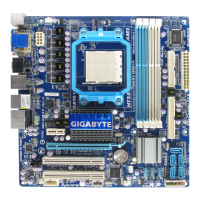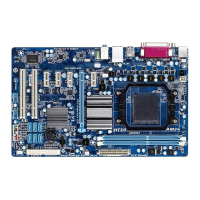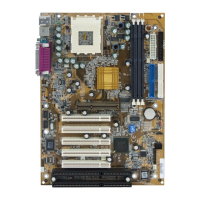
Do you have a question about the Gigabyte GA-785GMT-USB3 and is the answer not in the manual?
| Number of memory slots | 4 |
|---|---|
| Maximum internal memory | 16 GB |
| Processor socket | Socket AM3 |
| Processor manufacturer | AMD |
| USB 2.0 connectors | 3 |
| S/PDIF out connector | Yes |
| Number of SATA connectors | 5 |
| Controller interface type | SATA |
| Controller 2nd interface type | IDE |
| USB 2.0 ports quantity | 6 |
| Power source type | ATX |
| Motherboard chipset | AMD 785G |
| Audio output channels | 7.1 channels |
| Motherboard form factor | micro ATX |
| Compatible operating systems | Windows Vista / XP |
| RAID levels | 0, 1, 1+0, JBOD |
| LAN controller | Realtek RTL8111C |
| Networking features | Gigabit Ethernet |
| Width | 243 mm |
|---|
Guidelines for safe installation, focusing on ESD protection and proper component handling.
Lists detailed technical specifications for the motherboard, including CPU, memory, and interfaces.
Step-by-step instructions for installing the CPU and attaching the CPU cooler securely.
Guide to installing DDR3 memory modules and configuring dual channel memory.
Procedure for installing expansion cards into PCI Express and PCI slots.
Configuration steps for ATI Hybrid CrossFireX to enhance graphics performance.
Explanation of the function and use of various ports on the motherboard's rear panel.
Diagram and pinout details for internal motherboard connectors.
Details screens shown during boot and function keys for BIOS access and utilities.
Overview of the BIOS Setup main menu, navigation, and key functions.
Advanced settings for CPU clock, frequency, and voltage adjustment for performance tuning.
Configuration for system date, time, and IDE/SATA/Floppy drive settings.
Settings for boot order, virtualization, onboard graphics, and system performance.
Configuration for onboard devices like SATA, LAN, Audio, and USB controllers.
Settings related to ACPI sleep states, power button functions, and wake-up events.
Management of Plug and Play devices and PCI slot IRQ assignments.
Monitoring system temperatures, voltages, fan speeds, and hardware status.
Resets BIOS to the safest and most stable default settings.
Resets BIOS to optimal default settings for performance.
Allows setting passwords to protect BIOS access and system startup.
Saves BIOS configuration changes and exits the setup utility.
Exits BIOS setup without saving any modifications made.
Guide to installing essential chipset drivers from the included driver disk.
Lists and describes GIGABYTE utilities and bundled software for installation.
Access to application guides, driver descriptions, and motherboard manuals.
Provides contact information for GIGABYTE technical support and offices worldwide.
Displays basic system information such as motherboard model and BIOS version.
Links to GIGABYTE's website for the latest BIOS, drivers, and software downloads.
Quick access to GIGABYTE's latest developed utilities for user installation.
Utility for quick system data backup and restoration, supporting NTFS/FAT file systems.
Tools for updating BIOS: Q-Flash (DOS/BIOS) and @BIOS (Windows).
Software for system tuning, overclocking, and hardware monitoring in Windows.
Technology for optimizing power savings and enhancing energy efficiency.
Tool for convenient data sharing across a network.
Utility for creating backups of changed data files and recovering them.
Enables system power savings using a Bluetooth cell phone as a security key.
Guide to installing SATA drives, configuring SATA controller modes, and setting up RAID.
Instructions to create a driver diskette for SATA RAID/AHCI controllers for OS installation.
Steps for installing SATA RAID/AHCI drivers and the OS (Windows XP/Vista).
Process for restoring data by rebuilding fault-tolerant RAID arrays after drive failure.
Guide to configuring audio jacks for multi-channel sound and input/output.
Detailed steps for setting up various multi-channel audio configurations.
Instructions for installing and configuring S/PDIF connectors for digital audio.
Enhances audio by transforming stereo content into multi-channel surround sound.
Steps to connect and configure microphone input for sound recording.
How to record and play audio using the Sound Recorder utility.
General troubleshooting guidance for system startup and operational issues.
Answers to common questions about BIOS options, power, and driver installation.
A flowchart-based guide to diagnose and resolve system startup problems.
Contains regulatory notices, including RoHS and WEEE compliance information.











